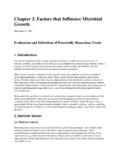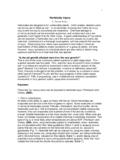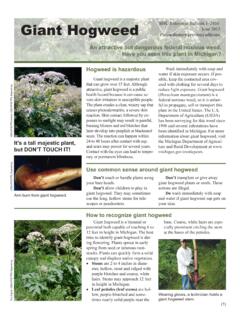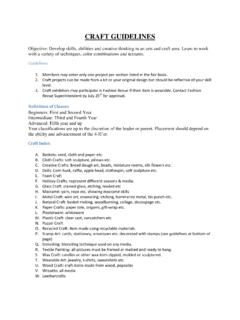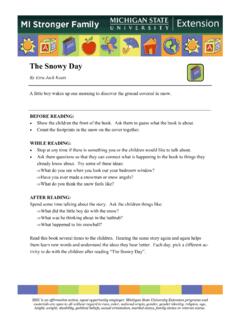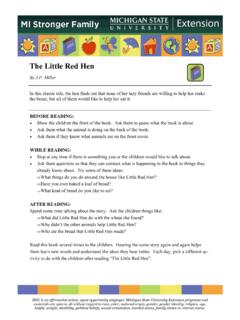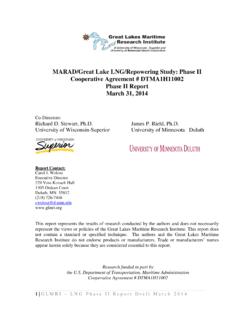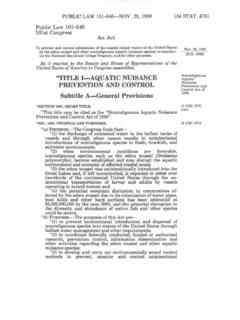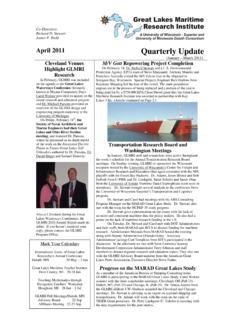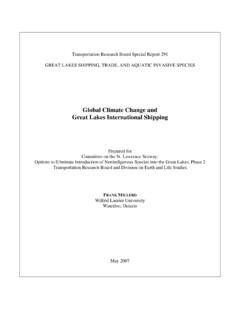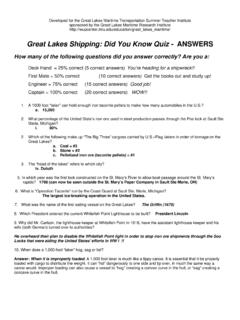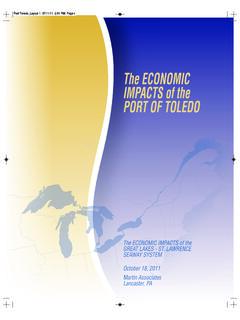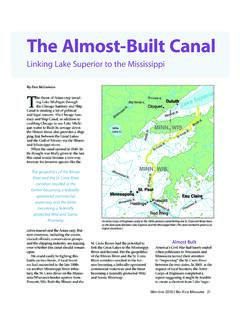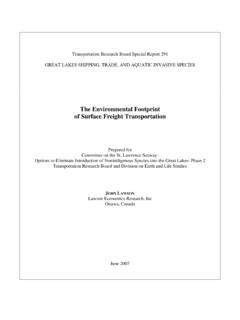Transcription of Great Lakes Sea Grant Network EDUCATION ... - MSU …
1 Great Lakes Sea Grant Network EDUCATION AND OUTREACH ON. ASIAN CARP. In Support of the Asian Carp Regional Coordinating Committee Patrice Charlebois and Sarah Zack, Illinois-Indiana Sea Grant Daniel O'Keefe and Charles Pistis*, Michigan Sea Grant Doug Jensen, Minnesota Sea Grant Helen Domske and Dave MacNeill*, New York Sea Grant Dr. Christopher Winslow, Tory Gabriel, and Dr. Jeffrey Reutter*, Ohio Sea Grant Sarah Whitney, Pennsylvania Sea Grant Dr. Titus Seilheimer and Dr. Phil Moy*, Wisconsin Sea Grant *no longer with program Great Lakes RESTORATION.
2 Great Lakes Network Contents Understanding the Threat 3. Current and future research in Asian carp management and control EDUCATION and Outreach Materials 20. Experts and Contact Information 25. Analysis of EDUCATION and Outreach 30. Asian Carp PowerPoint and Presenter Notes 40. A comprehensive PowerPoint slideshow for educational and outreach events regarding Asian carp is available to download at For more information on the developers of this document, visit these websites: Asian Carp Regional Coordinating Committee (ACRCC). Thanks to the Great Lakes Sea Grant Network for 2017 The Ohio State University their valuable contributions to this document.
3 Publication OHSU-TB-1511 2017. EDUCATION AND OUTREACH ON ASIAN CARP In Support of the Asian Carp Regional Coordinating Committee 2. Understanding the Threat Current and Future Research in Asian Carp Management and Control EDUCATION AND OUTREACH ON ASIAN CARP In Support of the Asian Carp Regional Coordinating Committee 3. Understanding the Threat Titus Seilheimer, University of Wisconsin Sea Grant Institute Phil Moy, Water Resources Department, lake County, California INTRODUCTION. THE THREAT. Silver Carp The term Asian carp can evoke images of dozens of large fish leaping from water, startled by boat engines and colliding with boats and people.
4 The fish in these well- known videos are predominantly Silver Carp (Hypophthalmichthys molitrix), though the broader term, Asian carp, includes three additional non-native carp species of Asian origin currently in North America: Bighead Carp (Hypophthalmichthys nobilis), Grass Carp (Ctenopharyngodon idella), and Black Carp (Mylopharyngodon piceus). Bighead Carp Unfortunately, these invasive fish present more concerns than just the threat of injury to recreational boaters. Asian carp were brought to the United States in the 1960s (Grass Carp) and 1970s (other three species).
5 For use in aquaculture, but these species eventually made their way to the Mississippi River watershed and have been expanding their range since. Silver and Bighead Carp feed on plankton by filtering it out of the water (filter feeders), while Grass Carp eat vegetation and Black Carp eat mollusks, like clams and snails. Asian carp are voracious Grass Carp and often outcompete native fish for food and habitat, which is of Great concern to wildlife and resource managers. Due to their potential negative impacts, Bighead, Silver, and Black Carp are now listed as injurious.
6 Species by the Fish and Wildlife Service, which can invoke legal transportation limitations. The movement of Grass Carp is regulated by many individual states as well. When discussing the threat to the Great Lakes , Silver and Bighead Carp are Black Carp EDUCATION AND OUTREACH ON ASIAN CARP In Support of the Asian Carp Regional Coordinating Committee 4. Understanding the Threat commonly referenced as these are the two species moving up the Illinois River toward the Chicago Area Waterways System (CAWS). The CAWS connects the Mississippi River basin to the Great Lakes through a series of canals used for shipping , storm and wastewater discharge, and recreation.
7 Additionally, Grass Carp are already present in the Great Lakes watershed, and there is evidence of successful Grass Carp spawning in the Sandusky River, a lake Erie tributary. Black Carp are found in the Mississippi River, currently near the Iowa-Missouri border, but they are moving north toward new habitats. WHY THE CONCERN. Aside from the potential bodily harm that Silver Carp can cause to boaters, the ecosystem impacts that these four species are having in their current range will occur to varying degrees in the Great Lakes if they become established.
8 The primary concern is that Asian carps will impact the already stressed Great Lakes food web. Once these fish become established, impacts to native species will likely occur directly through competition for food, or indirectly though changes to the food web. In parts of the Illinois River, Silver and Bighead Carp are now the dominant fish species, making up more than 90% of the fish biomass. Both species are filter feeders that compete with other fish that feed lower on the food web, such as forage fish (such as minnows and shad), young sport fish, and other commercially important species.
9 All four non- native carp species are also fast growing and can quickly escape predation. In ideal conditions, they can grow large enough in their first year to no longer be vulnerable to most predators. The location of the Silver and Bighead Carp invasion front in the Illinois River is currently the Dresden Island Pool of the Des Plaines River, which is about 18 river miles downstream from the Electric Dispersal Barrier and 55 river miles from lake Michigan. Although Silver and Bighead Carp receive much of the media focus, Black and Grass Carp are also a threat to native species and ecosystems, as well as recreation and economies.
10 Provided here is brief synopsis of project information derived from visits and interviews of ongoing research to control and manage Asian carp. The research is divided into Life History, Movement and Behavior, Prevention and Control, Ecosystem Changes, and the Great Lakes , and concludes with Knowledge Gaps. EDUCATION AND OUTREACH ON ASIAN CARP In Support of the Asian Carp Regional Coordinating Committee 5. Understanding the Threat LIFE HISTORY. Asian carp spawning occurs in rivers, and water flow is an important component of the life cycle. Eggs are fertilized upstream, the eggs hatch and the larvae drift downstream until they are developed enough to swim on their own.
